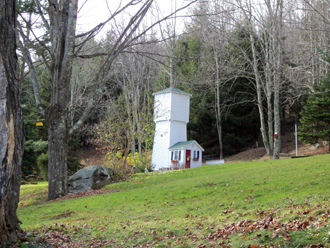That’s what I asked Maggie Braton up on Searles Road as I was out walking the dog one Indian summer Sunday. She has an unusual white wooden tower in her neatly manicured yard. An odd sight. Turns out the top of the tower contains a tank capable of holding several hundred gallons of water, pumped up from a well and distributed through a network of pipes and spigots to serve a long-gone pheasant house and, she says, a small herd of cows. A bit of research in the Catskill Mountain News, Ethel Bussy’s History of Margaretville and other sources introduced me to the gracious world of wealthy summering in the Catskills.

Water tower at The Ark
For some time prior to 1902, E. V. Hallock had an estate here. It was known as ‘The Ark,’ and what had been called Kittle Hill (for the family that settled there in the late 1700s) became known as Hallock Hill. Not sure what line of work Mr. Hallock was in, but he quickly made improvements that made it “one of the most pleasant summer resorts in the Catskills.” He could afford to hire G. L. Hull to manage his farm; John Atkin to build a tool house, office and “seed house”; and George Kenyon and Harry Coulter to do carpentry and painting at his property on Long Island. He was likely the one who had the stone gate built at the entrance to the winding road up to the house, and the “hanging gardens,” stone-terraced flower beds and koi ponds on the hillside.
In 1902, Mr. Halleck had a log cabin built at the summit for his daughters and guests to play and party in. During a sleepover that summer, a lightning strike near the cabin split a wooden flagpole in half and struck terror into the hearts of the young campers.
In October of 1904, 50 guests came up by special train and stayed at the Pakatakan Inn in Arkville to attend the wedding at The Ark of the Hallecks’ daughter, Elizabeth, to Army Captain William Rogers. A second daughter, Mary, married Edward Bennett in 1907 and eventually inherited the place and the summering tradition.
Mr. Bennett died in 1928 after a year long illness. His obituary called him a “world traveler,” but didn’t mention an occupation. Mrs. Bennett and daughter Frances continued to spend summers at The Ark there through the 1930s, while another family, the Roneys, rented various homes in the vicinity for their own annual summer sojourns. At some point, Ethel Bussy says, Mr. and Mrs. E. H. Roney acquired The Ark, restored the gardens, and had the “large, rambling” house taken down with the intention of building a stone one that never materialized. Mr. Roney died by his own hand in the 195s.
The Burke family now owns most of the former mountainside estate; Maggie Braton’s parents bought the caretaker’s house next to the charming little water tower in the 1960s. If anyone has photos or facts to add to this brief history, please contact us!

The Ark Residence of E. H. Bennett. Searles Rd. not Arkville. July 25, 1939
